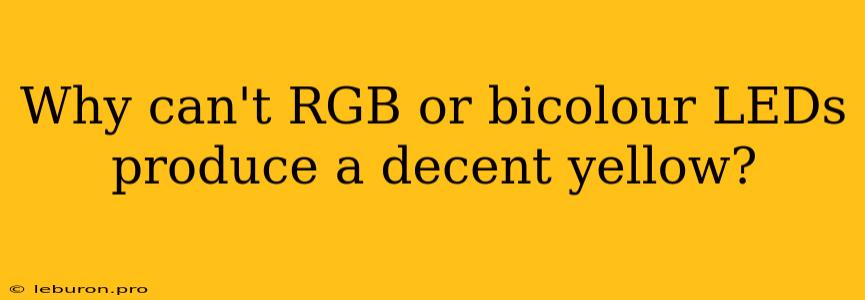The quest for a perfect yellow in LED lighting has been a long and challenging one. While RGB (red, green, blue) and bicolour LEDs are capable of generating a wide spectrum of colors, achieving a true and vibrant yellow has proven to be elusive. This article delves into the scientific and technical reasons why these LEDs struggle to produce a satisfying yellow hue, exploring the limitations and challenges involved.
The Nature of Color and Light
Understanding the nature of color and light is crucial to comprehending the difficulties associated with creating a decent yellow with RGB or bicolour LEDs.
Color is our perception of the wavelengths of light that reach our eyes. Visible light is a form of electromagnetic radiation with wavelengths ranging from approximately 380 nanometers (violet) to 750 nanometers (red). When white light, which contains all wavelengths of visible light, passes through a prism, it is separated into its constituent colors. This is known as dispersion.
LEDs (Light Emitting Diodes) are semiconductor devices that emit light when an electrical current passes through them. They are known for their efficiency, longevity, and ability to produce a variety of colors. However, the color of light emitted by an LED is determined by the specific semiconductor material used.
The RGB Color Model and Its Limitations
RGB (Red, Green, Blue) is a widely used additive color model that utilizes three primary colors – red, green, and blue – to create a vast range of colors by mixing them in various proportions. In the digital world, RGB values are often expressed as a combination of three numbers, each representing the intensity of red, green, and blue on a scale from 0 to 255.
While RGB LEDs are highly versatile, they face limitations when it comes to generating certain colors, including yellow.
The Challenge of Mixing Red and Green for Yellow
A common approach to producing yellow with RGB LEDs involves mixing red and green light. However, this method often results in a yellowish-green hue that lacks the warm and vibrant quality of a true yellow. This is due to several factors:
-
Limited Spectral Bandwidth: The spectral bandwidth of red and green LEDs is relatively narrow, meaning they emit light within a limited range of wavelengths. When these two colors are mixed, the resulting yellow lacks the broader spectrum of wavelengths that characterize a natural yellow.
-
Color Perception and the Human Eye: Human eyes are more sensitive to certain wavelengths than others. When we see yellow, our eyes are more sensitive to the longer wavelengths in the yellow region of the spectrum. However, the yellow produced by mixing red and green LEDs often lacks these longer wavelengths, leading to a less satisfying yellow hue.
-
Phosphor Conversion and its Impact on Color Purity: Some RGB LEDs employ phosphor conversion technology, where blue light emitted by the LED is converted into other colors by passing it through a phosphor material. While phosphor conversion can help to produce a wider range of colors, it can also lead to a reduction in color purity and introduce unwanted color artifacts.
Bicolour LEDs and Their Limitations
Bicolour LEDs are designed to emit two distinct colors. This is achieved by using two different semiconductor materials within a single LED package, allowing them to switch between two colors. While they offer more flexibility than single-color LEDs, they also struggle to produce a satisfactory yellow.
The Lack of a Dedicated Yellow Emitter
Bicolour LEDs typically incorporate red and green emitters. The lack of a dedicated yellow emitter means that generating yellow requires mixing red and green light, which, as discussed previously, presents challenges in achieving a true and vibrant yellow.
Achieving a Decent Yellow with LEDs: The Quest Continues
Despite the challenges, ongoing research and development efforts aim to improve the ability of LEDs to generate a desirable yellow. Some potential solutions include:
-
Improved Phosphor Materials: The development of new and more efficient phosphor materials could lead to more accurate and vibrant yellow hues.
-
Advanced LED Chip Designs: Optimizing LED chip designs to produce a broader spectrum of wavelengths in the yellow region could contribute to a richer and more natural yellow.
-
Multi-Chip LED Solutions: Using multiple LEDs with different color emissions and precise control over their intensities can potentially achieve a more accurate and vibrant yellow.
-
White LED with Color Tuning: Combining a white LED with a separate color tuning mechanism can allow for fine-tuning of the yellow color, potentially producing a more satisfactory result.
Conclusion
Producing a decent yellow with RGB or bicolour LEDs remains a challenge due to the inherent limitations of these technologies. The narrow spectral bandwidth of red and green emitters, color perception biases, and the use of phosphor conversion all contribute to the difficulty in achieving a true and vibrant yellow. However, ongoing research and technological advancements offer hope for a future where LEDs can reliably and accurately generate a wide range of colors, including a truly satisfying yellow. While the quest for a perfect yellow in LED lighting continues, the pursuit of innovation and scientific breakthroughs is a testament to the constant evolution of this essential technology.
